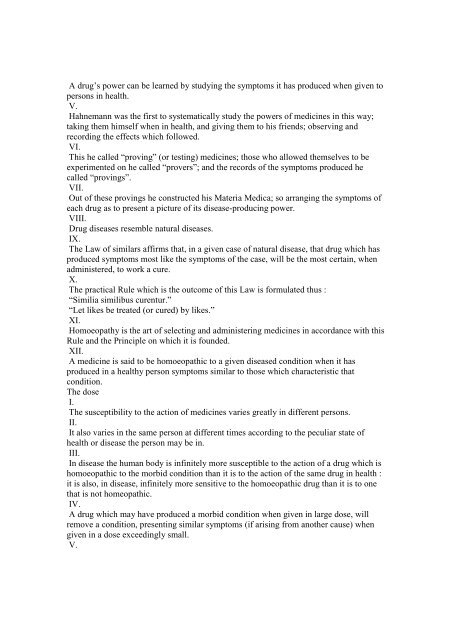CLARKE JH, Homoeopathy Explained - Classical Homeopathy Online
CLARKE JH, Homoeopathy Explained - Classical Homeopathy Online
CLARKE JH, Homoeopathy Explained - Classical Homeopathy Online
Create successful ePaper yourself
Turn your PDF publications into a flip-book with our unique Google optimized e-Paper software.
A drug’s power can be learned by studying the symptoms it has produced when given to<br />
persons in health.<br />
V.<br />
Hahnemann was the first to systematically study the powers of medicines in this way;<br />
taking them himself when in health, and giving them to his friends; observing and<br />
recording the effects which followed.<br />
VI.<br />
This he called “proving” (or testing) medicines; those who allowed themselves to be<br />
experimented on he called “provers”; and the records of the symptoms produced he<br />
called “provings”.<br />
VII.<br />
Out of these provings he constructed his Materia Medica; so arranging the symptoms of<br />
each drug as to present a picture of its disease-producing power.<br />
VIII.<br />
Drug diseases resemble natural diseases.<br />
IX.<br />
The Law of similars affirms that, in a given case of natural disease, that drug which has<br />
produced symptoms most like the symptoms of the case, will be the most certain, when<br />
administered, to work a cure.<br />
X.<br />
The practical Rule which is the outcome of this Law is formulated thus :<br />
“Similia similibus curentur.”<br />
“Let likes be treated (or cured) by likes.”<br />
XI.<br />
<strong>Homoeopathy</strong> is the art of selecting and administering medicines in accordance with this<br />
Rule and the Principle on which it is founded.<br />
XII.<br />
A medicine is said to be homoeopathic to a given diseased condition when it has<br />
produced in a healthy person symptoms similar to those which characteristic that<br />
condition.<br />
The dose<br />
I.<br />
The susceptibility to the action of medicines varies greatly in different persons.<br />
II.<br />
It also varies in the same person at different times according to the peculiar state of<br />
health or disease the person may be in.<br />
III.<br />
In disease the human body is infinitely more susceptible to the action of a drug which is<br />
homoeopathic to the morbid condition than it is to the action of the same drug in health :<br />
it is also, in disease, infinitely more sensitive to the homoeopathic drug than it is to one<br />
that is not homeopathic.<br />
IV.<br />
A drug which may have produced a morbid condition when given in large dose, will<br />
remove a condition, presenting similar symptoms (if arising from another cause) when<br />
given in a dose exceedingly small.<br />
V.
















